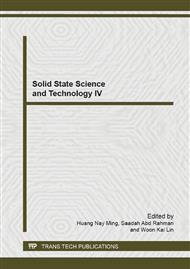p.162
p.169
p.174
p.181
p.186
p.190
p.194
p.200
p.204
Electro-Optic Potential of Room and High Temperature Polymer Stabilised Blue Phase Liquid Crystal
Abstract:
In the field of liquid crystals, blue phases (BPs) are one of the most unique and interesting sub-phases. Blue-phase liquid crystal holds the potential to become next-generation display and photonics device because of its sub-millisecond gray-to-gray response time, alignment-layer-free process, optically isotropic dark state, and cell gap insensitivity. The BPLC is a highly chiral liquid crystal system possessing crystal like unit cell structure and exist over a small temperature range (0.5-2 °C) between isotropic and chiral nematic (N*) thermotropic phase. The narrow phase range has been an intrinsic problem for blue phase, and a useful strategy of widening the phase is by adding polymer to form a polymer stabilised blue phase liquid crystal. In this paper, we demonstrate polymer stabilization using two different cases: a room temperature mixture containing E8, PE-5CNF and CPP-3FF, and a high temperature mixture using a single molecule blue phase liquid crystal material, TCB5. Comparison of the polymer stabilization effects on these two cases will be discussed, in the perspective of their potential in electro-optic applications.
Info:
Periodical:
Pages:
186-189
Citation:
Online since:
February 2014
Keywords:
Price:
Сopyright:
© 2014 Trans Tech Publications Ltd. All Rights Reserved
Share:
Citation:


